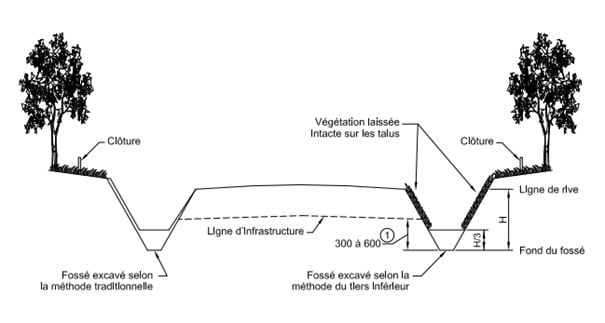How to dig a ditch for drainage
Digging ditches and trenches is one of the most common jobs that excavation companies are asked to do.
Who better to share a wealth of information about ditch digging than our earthwork and excavation experts? This will come in handy if you are planning to dig a ditch or even considering hiring a company to do it.
Grab your shovels and let’s go!
What is a ditch?
A ditch is a long depression in the ground. Drainage ditches are a result of human ingenuity.
What is the purpose of a ditch?
Ditches are used to drain surface water, especially during periods of rainfall and snowmelt. They also act as basins for sedimentation and water storage. They capture soil particles and reduce the risk of these particles ending up in rivers and lakes. They can even contribute to the filtration of runoff water.
3 types of ditches
Party ditch
A party ditch serves as a dividing line between two adjacent properties.
Public or private road ditch
A public or private road ditch is used exclusively to drain a public or private roadway, such as a street, bike path or railroad.
Drainage ditch
The drainage ditch is used solely for drainage and irrigation of agricultural land.
What you need to know before digging a ditch
Digging a ditch probably takes more planning than you think. Here are a few things to pay attention to if you have a ditch digging project.
Ditch design
The design of a ditch has a significant impact on its ability to resist erosion and perform its function over a long period of time without requiring maintenance. For superior performance and durability, it is recommended to:
- Keep the depth of the ditch to a minimum (the depth from the subgrade line to the bottom of the ditch should be between 0.30 and 0.60 m).
- Design the ditch side slopes with as much respect as possible for the angle at which the soil rests and vegetation develops. Ideally, the slope should be gentler than a 2:1 ratio (50% slope).
- Design the ditch to have a bottom width of 0.60 to 1.80 m to promote water infiltration and filtration.
When is the best time of year to dig a ditch?
Ditch digging is usually done between the end of the thaw period and when conditions no longer permit digging.
However, excavation work should be done during dry weather to limit sediment carryover.
Equipment needed to dig a ditch
The first thing you need to dig a ditch is a mechanical shovel. This heavy equipment will allow the operator to dig into the ground and move the excavated soil.
An excavator with wheels or protected tracks should be used for roadside work to avoid damaging the asphalt. Furthermore, the excavator should have a relatively small bucket size to give the operator a clear view of the bottom of the ditch.
It is recommended that an emergency kit be kept on site to respond quickly in case of spills or leaks of hydrocarbons or any other harmful substance.
A laser level can also be handy to make sure you create the right slope and maintain the right direction of the ditch. High-visibility markers and paint can also help the operator dig in the right place.
Do you need a permit to dig a ditch?
Before starting to dig a ditch in Quebec, you are required to verify if a certificate of authorization from the Ministère du Développement durable, de l’Environnement et de la Lutte contre les changements climatiques is necessary.
A municipal inspector will be able to guide you through the steps to take.
Beware of underground infrastructure
Many public infrastructures such as gas and water distribution networks are buried. Even when doing residential excavation, you will need to check if there are any in the area where you want to dig a ditch. You can use a service like Info-Excavation to check if there are any. This will help you avoid damage requiring sewer or aqueduct repair work!
Some tips to make digging a ditch easier
- Digging a ditch from the bottom of the slope upwards (from downstream to upstream) makes it easier to get the right slope. This will also ensure that water runoff does not complicate the work.
- If your ditch is going to involve a change in direction, it is better to create a curve than a right angle. Right angles tend to erode quickly.
When digging an existing ditch
Drainage system maintenance should not be neglected. This means regularly cleaning the ditches.
This involves removing accumulated debris and sometimes digging an existing ditch to restore its effectiveness.
Why dig an existing ditch?
An existing ditch may need to be excavated as a result of one of the following conditions:
- An obstruction to the free flow of water
- More than 150 mm of sediment accumulation above the original ditch level
- Insufficient depth of the existing ditch to ensure proper drainage (at least 150 mm below the subgrade line)
The lower third method
When possible, the lower third method should be prioritized when cleaning a ditch.
This consists of excavating only the lower third of the total depth of the ditch. Above the lower third, the embankments are left intact, thus preserving the vegetation in place.
This method involves clearing the ditch and cutting the peat before digging to a depth of no more than 600 mm below the subgrade line.
Once the ditch excavation is complete, revegetate the bare soil with a herbaceous plant mix (where conditions permit).

Image illustrating the lower third method
Have a ditch to dig? Excavation Chanthier is here for you!
Now that you know what is involved in digging a ditch, you may find that you are better off leaving it to the experts rather than going the DIY route.
If so, you can trust our team. At Excavation Chanthier, we have all the necessary equipment and our operators are trained and certified.
Contact us today for all your excavation needs.







